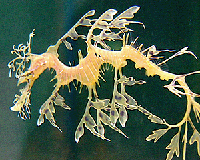Keeping Seadragons
When Pang Quong was a child he loved catching tadpoles, but that was only the beginning of a fascination with aquatic creatures which has lasted for decades. At his home there are about 30 aquariums containing fish, seahorses and seadragons. Seadragons are protected under fisheries legislation in most Australian states, and it’s illegal to take them from the wild. However Pang has a special permit which allows him to collect one pregnant seadragon per year, hatch the eggs and sell the babies to major aquariums around the world. Seadragons are not suitable pets for hobby collectors because they are very difficult to feed and maintain. Pang is totally dedicated to the care of his seadragons, so much so that he goes diving almost every day to net live shrimp for them to eat.
What are seadragons?
Seadragons are members of the family Syngnathidae, along with their close relatives the seahorses. They are poor swimmers, with tiny fins on their head and back for propulsion and tails which serve as rudders. The male seadragons brood the eggs, carrying them under the tail attached to nutritive tissue which acts like a placenta. After about a month the eggs hatch one by one as the adult drags its tail over the weedbeds, and in this way the young are scattered over a wide area. Seadragons are brilliantly camouflaged – they look like bits of floating seaweed, and this enables them to be ‘sit and wait’ predators. They have small mouths at the end of long, pipe-like snouts, and they snap up passing mysid shrimp and other small crustaceans with a quick, trigger like action. Pang keeps two kinds of seadragon, the weedy seadragon and the leafy seadragon.
Common or Weedy seadragon (Phyllopteryx taeniolatus)
The weedy seadragon is about 30-45cm (12-18") long, and has iridescent blue stripes on the chest, with many white spots and yellow markings over an orange-red background colour. It lives on reefs from 1-50m (3-160′) in depth, and can be found from southern Western Australia to the New South Wales central coast and around Tasmania.
Leafy seadragon (Phycodurus eques)
This rare and beautiful species is found in southern Australian waters as well as some parts of Western Australia. It is about 35cm (14") long with numerous spikes and branched appendages on the edge of its body, giving it a delicate seaweed-like appearance. The leafy outline and orange/red/brown colour of this spectacular creature help it blend perfectly with its seagrass and algal habitat.
Further information
Pang Quong, phone: (03) 9786 3319, email: [email protected] Seadragons can be seen at ‘Underwater World’, Hillarys Boatharbour, near Perth, and at the new Melbourne Aquarium in December.



